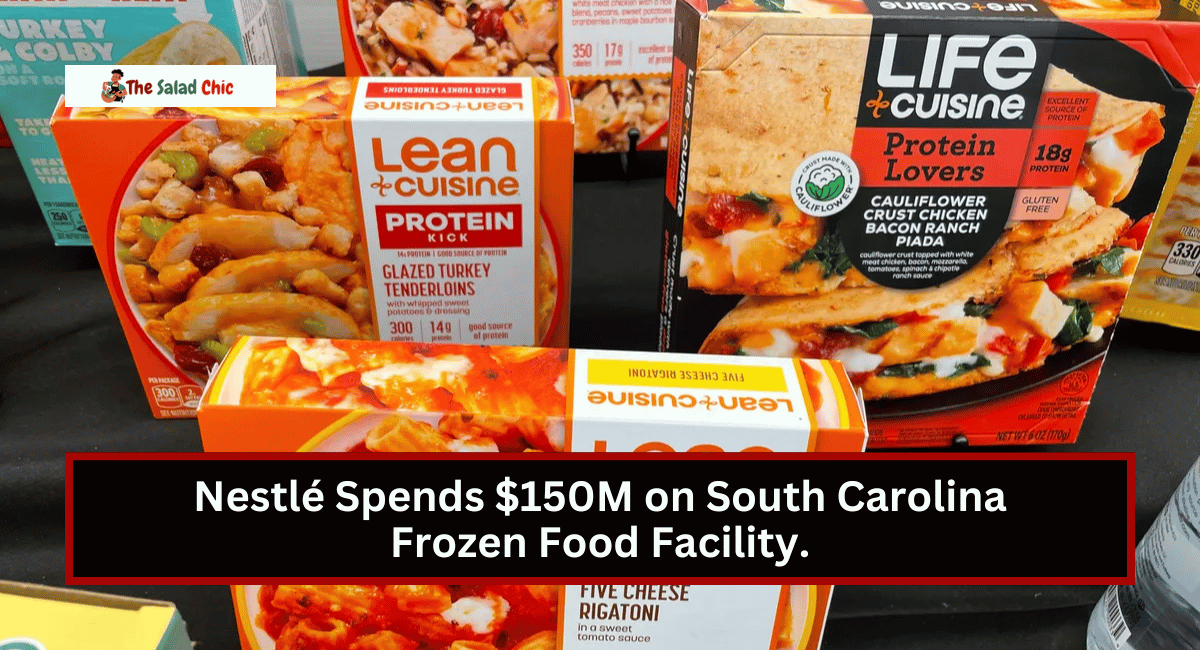Nestlé, the global packaged food giant, is investing significantly in its U.S. operations. The company announced a $150 million expansion of its Gaffney, South Carolina, facility.
Opened in 1980, this plant is a cornerstone for Nestlé’s production of beloved frozen meal brands such as Stouffer’s and Lean Cuisine.
The investment will fund a new production line for single-serve frozen meals and upgrade the facility’s automation and digital technology to boost efficiency and meet growing consumer demand.
Why Is Nestlé Expanding Now?
The U.S. frozen food market is experiencing rapid growth. Valued at $56 billion in 2021, the segment is projected to grow at a compound annual growth rate (CAGR) of 4.7% through 2030, according to Grand View Research.
Several factors are driving this growth:
- Time Constraints: Consumers increasingly turn to frozen meals for convenience, as busy lifestyles leave little time for cooking.
- Inflationary Pressures: Rising costs have made dining out less affordable, prompting families to prepare meals at home instead.
Nestlé’s decision reflects a strategic move to align with these market trends. “This investment demonstrates our ongoing commitment to enhancing our U.S. manufacturing footprint and in-house capabilities,” said Nicole Caldwell, factory manager for Nestlé USA in Gaffney.
Enhancements to the Gaffney Plant
The $150 million will bring significant improvements to the facility, including:
- New Production Line: Dedicated to single-serve frozen meals to address increasing demand.
- Advanced Technology: Upgrades in automation and digital tools will enhance productivity and streamline operations.
- Job Opportunities: Although Nestlé has not specified the exact number, such expansions often create local employment opportunities.
These enhancements will help Nestlé meet growing demand for its frozen meal brands, including Hot Pockets, DiGiorno, and Sweet Earth, as well as new offerings like Vital Pursuit, which caters to health-conscious consumers.
Challenges in the Frozen Food Market
Despite the promising outlook for frozen foods, Nestlé has faced some hurdles. For the first nine months of this year, the company reported negative growth in its North American frozen food category. This was attributed to intense competition, particularly in the frozen pizza market.
Brands like DiGiorno and California Pizza Kitchen are feeling the heat as rivals continue to innovate and capture market share. However, with its extensive portfolio and focus on innovation, Nestlé aims to regain momentum.
Nestlé Joins Industry-Wide Manufacturing Overhauls
Nestlé isn’t alone in upgrading its manufacturing capabilities. Other major food companies are also making moves to improve efficiency and adapt to shifting market dynamics:
- PepsiCo is building a 1.2 million-square-foot plant in Colorado, its largest U.S. facility.
- Campbell Soup Company plans to invest $230 million in modernizing its plants through 2026 and close one outdated facility.
- Companies like Flowers Foods, Del Monte Foods, and Conagra Brands have also announced closures of inefficient plants to streamline operations.
This trend highlights the growing need for food manufacturers to balance production capacity with consumer demand while staying competitive in a fast-evolving market.
The Future of Frozen Food
Nestlé’s investment underscores its confidence in the frozen food market’s long-term potential. As more consumers prioritize convenience and affordability, frozen meals are poised to remain a popular choice.
The company’s focus on enhancing production and expanding its offerings shows its commitment to adapting to consumer preferences. While competition remains fierce, Nestlé’s strong brand portfolio and innovation efforts position it to thrive in this growing segment.
Conclusion
Nestlé’s $150 million investment in its Gaffney, South Carolina, plant is a testament to its confidence in the frozen food market’s growth potential. With consumer preferences shifting toward convenient and affordable meal options, the company strategically positioned itself to capitalize on this demand.
By enhancing production capabilities and leveraging its strong brand portfolio, Nestlé is poised to navigate market challenges and remain a leader in the frozen food industry.
As competitors also upgrade their operations, the race to innovate and adapt will shape the future of food manufacturing.
FAQs
Why is Nestlé investing $150 million in its Gaffney, SC, plant?
Nestlé is investing $150 million to expand its Gaffney facility to meet rising consumer demand for frozen meals. The investment will add a new production line for single-serve meals and enhance automation and digital technology.
What frozen food brands does Nestlé produce?
Nestlé’s frozen food portfolio includes popular brands like Stouffer’s, Lean Cuisine, Hot Pockets, DiGiorno, and Sweet Earth, as well as its new brand, Vital Pursuit.
How is the U.S. frozen food market performing?
The U.S. frozen food market was valued at $56 billion in 2021 and is expected to grow at a compound annual growth rate of 4.7% through 2030. Convenience and affordability are key drivers of this growth.
What challenges is Nestlé facing in the frozen food category?
Nestlé has experienced negative growth in its North American frozen food segment due to intense competition, particularly in the frozen pizza market.
Are other companies making similar manufacturing investments?
Yes, many food companies are investing in new or upgraded facilities. For example, PepsiCo and Campbell Soup are modernizing their operations, while others, like Del Monte, are closing inefficient plants.
READ MORE: The 7 Best Winter Hearth Stouts

